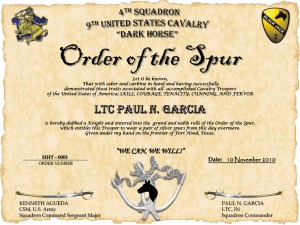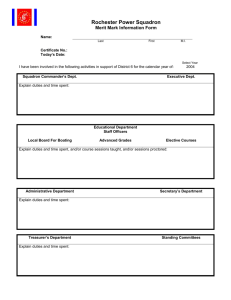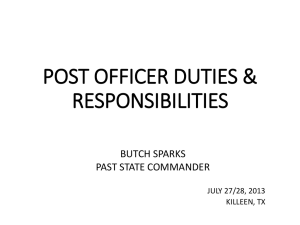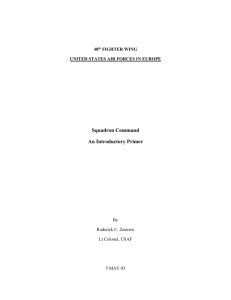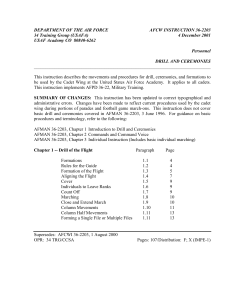Lesson Plan - CAP Members
advertisement
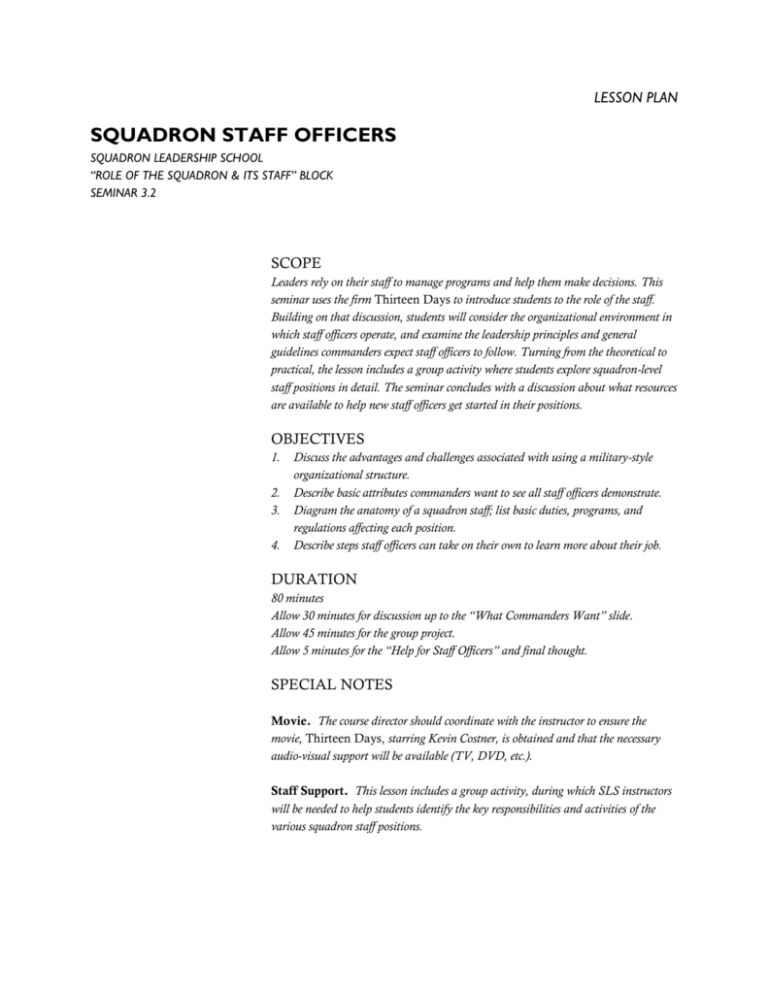
LESSON PLAN SQUADRON STAFF OFFICERS SQUADRON LEADERSHIP SCHOOL “ROLE OF THE SQUADRON & ITS STAFF” BLOCK SEMINAR 3.2 SCOPE Leaders rely on their staff to manage programs and help them make decisions. This seminar uses the firm Thirteen Days to introduce students to the role of the staff. Building on that discussion, students will consider the organizational environment in which staff officers operate, and examine the leadership principles and general guidelines commanders expect staff officers to follow. Turning from the theoretical to practical, the lesson includes a group activity where students explore squadron-level staff positions in detail. The seminar concludes with a discussion about what resources are available to help new staff officers get started in their positions. OBJECTIVES 1. 2. 3. 4. Discuss the advantages and challenges associated with using a military-style organizational structure. Describe basic attributes commanders want to see all staff officers demonstrate. Diagram the anatomy of a squadron staff; list basic duties, programs, and regulations affecting each position. Describe steps staff officers can take on their own to learn more about their job. DURATION 80 minutes Allow 30 minutes for discussion up to the “What Commanders Want” slide. Allow 45 minutes for the group project. Allow 5 minutes for the “Help for Staff Officers” and final thought. SPECIAL NOTES Movie. The course director should coordinate with the instructor to ensure the movie, Thirteen Days, starring Kevin Costner, is obtained and that the necessary audio-visual support will be available (TV, DVD, etc.). Staff Support. This lesson includes a group activity, during which SLS instructors will be needed to help students identify the key responsibilities and activities of the various squadron staff positions. INTRODUCTION State your topic and introduce yourself. ATTENTION / FILM CLIP Show the clip from the movie Thirteen Days where President Kennedy’s staff briefs him in the Oval Office on their proposal to quanatine Cuba. START (39:02) Black & white shot of a helicopter, followed by Secretary Rusk saying, “Mr. President, our deliberations have lead us to the conclusion...” STOP (41:27) President Kennedy: “Thank you all for your advice.” DISCUSSION QUESTIONS: Does President Kennedy have a good staff? In this scene, what is the staff doing in service to the president’s leadership and decision-making process? ANTICIPATED RESPONSES: Replies may vary; some important points to bring out include: 1. Technical Expertise. The staff’s technical expertise is a given. They knew the location of Soviet ships, the ships’ timelines, etc. 2. Authority. They presented the issue to the president. No one attempted to make such a huge decision on their own authority. 3. Consensus. The staff had talked through the issue together and no one agency tried to exclude another. (This scene has State, CIA, SECDEF, Chair of Joints Chiefs, Justice / RFK, and the speechwriter present). 4. Coordination. The staff had coordinated the details of both the airstrike and quarantine options before talking with JFK. 5. Solution-Orientated. The staff did not simply state the problem – JFK already knew about it – but offered the president options and explained why the quarantine idea seemed to be the least bad of the imperfect options. 6. Language. In speaking with the president, the staff was direct and honest. They used everyday language, and no one tried to use big words to obfuscate their position or duck the tough issues. 7. Courage. Amb. Stevenson showed courage in recommending diplomacy, however that option ran completely counter to the president’s “command intent.” (More on command intent later in this lesson.) In short, the staff supported the president’s leadership and decision-making process by bringing their technical expertise to bear on an important issue, thoroughly investigating the options, and presenting to JFK a specific but concise recommendation. TRANSITION / OVERVIEW The scene from Thirteen Days dramatizes principles of good staff work. It illustrates the vital role the staff plays in supporting a leader’s decisionmaking process. This next hour will take that discussion further by examining the role and basic responsibilities all staff officers have in common. Further, we’ll connect this topic to everyday CAP activities by looking at the various squadron staff positions in depth. THERE ARE PROS & CONS TO OUR MILITARY-STYLE ORGANIZATIONAL STRUCTURE INTRODUCTION Before we get too far ahead of ourselves in looking at the various squadronlevel staff positions, let’s first consider the basic organizational environment in which a CAP staff operates. Obviously, ours is a regimented, hierarchical structure that closely follows the military model. DISCUSSION QUESTIONS What advantages does CAP have in using a military-style hierarchy? What are some of the benefits to such a rigid structure? ANTICIPATED RESPONSE Will vary; what is important is that students recognize the pros and cons of each, as shown on the slide. Every organizational structure has drawbacks. What are some challenges of our military-style organizational structure? ANTICIPATED RESPONSE Will vary; what is important is that students recognize the pros and cons of each, as shown on the slide. SUMMARY Borrowing from the Air Force tradition of a regimented organizational structure, our chain of command is part of our culture. The challenge for staff officers is to leverage the benefits of such a system – making use of the logic, order, and predictability we discussed moment ago – while keeping our eyes open for the structure’s shortfalls – the bureaucracy, the turf battles, the lack of democracy which can frustrate our attempts to build a consensus which is so crucial in a volunteer environment. TRANSITION Next, let’s consider the personal and leadership traits staff officers need to succeed. COMMANDERS RELY ON THEIR STAFF OFFICERS’ EXPERTISE DISCUSSION QUESTION Put yourself in the place of the commander for a moment. Perhaps you have command experience in CAP or the military, or perhaps you’re a manager in the business world. What expectations would you have of your staff officers? What sort of guidelines or leadership principles would you want your staff to follow as they support you? ANTICIPATED RESPONSES: Responses may vary; see below for an explanation of the slide’s bullet points. 1. Know Your Job. Know the rules and regulations and standard practices that govern your position. Understand how your job affects other positions on the staff and the squadron’s overall mission 2. Do Your Job. If you volunteer to do something, do it. Be thorough and conscientious. People are counting on you. 3. Be a Responsible Volunteer. You’re a volunteer juggling work, family, and other commitments. Everyone understands that. But if you don’t have time to do an aspect of your job, or if you need to take a break from CAP for a while, tell your commander so other plans can be made to cover your absence. 4. Don’t Surprise the Commander. Keep the commander informed of what’s going on in your staff area. No one likes to be surprised. Commanders don’t want the staff to make big changes without any warning or clearance. When working a big project, it is a good idea to brief the commander and other interested staff officers on three occasions: Kickoff Meeting: This is where you explain to the commander your vision, goals, and general approach to the project. Your goal is to get the boss to give you the green light to proceed. Update Meeting: At some point during the project, meet with the commander and update him or her on its status. Are you on schedule? Do you have enough resources? Do you need the commander to intervene in some way? Hotwash Meeting: When the project concludes, meet with the commander to discuss how the project transpired. What went well? What can be improved for next time? 5. Follow the Commander’s Intent. This is the basic philosophy or vision a commander has for a program. It also includes the commander’s attitude toward everyday squadron business. The commander’s intent should inform all of your activities as a staff officer. By knowing the commander’s intentions, you can respond to issues in such a way that you know the commander would support your decisions. If you’re unsure what your commander’s intentions are, ask. 6. Make Decisions on Your Own. Your commander didn’t just “hire” you, he or she also hired your good judgment. The commander is counting on you to relive them of the need to make routine decisions. Use your judgment to make decisions wisely. But, if you encounter a big problem or a sensitive issue, exercise good judgment by bringing it to the commander’s attention before you act. 7. Play Well With Others. Every team experiences problems, conflicts, and personality issues. It’s how you deal with them that counts. The difference between a good staff member and a great staff officer is the ability to work well with others. If you become involved in a dispute with another staff member, try to solve the problem on your own. Be tactful. Fix the problem, don’t fix blame. Recognize the commander has better things to do for the squadron than play referee. 8. Suggest Solutions. If you’re an observant staff officer, you’ll start seeing the problems faced by the squadron. Some will be large, others minor. Part of your duty as a staff officer is to not only make the commander aware of those problems (he or she might know about them already) but to also suggest ways to solve them. Don’t be someone who brings only problems to the table. Bring solutions as well. 9. Find and Mentor Your Replacement. Most CAP squadrons are small. It is not easy for them to fill all the positions on the staff. You can help your commander by trying to find someone to succeed you in your current job, and by mentoring them so they have the knowledge necessary to succeed when you move on. 10. Have Fun. Volunteering in CAP is supposed to be fun. Sure, it takes hard work to build a great squadron and to accomplish our challenging missions, but if you’re not having fun you’re doing something wrong. TRANSITION With an understanding of the pros and cons of our military-style organizational structure, and an understanding of what leadership principles should guide staff officers, let’s turn to the specifics of squadron-level staff positions in CAP. ANATOMY OF A SQUADRON Before beginning the following group project, you may want to give the students a 5 minute break. GROUP PROJECT Divide the class into small groups of 2-4 students each. Working within their groups, have the students diagram the squadron’s organization. (A blank organization chart is included on the students’ handout.) Within each “box” on the organizational chart, have the students include the following: Name of Position Summary of Duties Key Activities, Events, Programs Key Deadlines / Reports Key Regulations Note Which Staff Positions Are Closely Related This project could be very time-consuming, depending on how detailed the students’ work is. It is not critical that the students’ produce a definitive, perfectly comprehensive organizational chart that lists every single activity, report, or regulation related to each staff position. Rather, the primary goal of this exercise is for students to understand the major positions within a staff, to understand how those positions relate, and most importantly, to understand how their particular specialty fits into the big picture. Keep in mind that during the “Individualized Training in Staff Specialties” seminar, students will have another opportunity to learn about their staff position in depth. To maximize the class’s use of time, it is suggested that the instructor not re-form the group to compare answers. Instead, have the SLS staff work closely with the small groups, giving students feedback as they work on the project. ANTICIPATED RESPONSE Answers may vary. Have the SLS staff monitor the groups during this project. The SLS staff will need to bring their subject matter expertise to bear, helping the groups identify the key activities, key regulations, etc. involved in each staff position. See CAPR 20-1 as a general reference. TRANSITION As you completed this activity, I’m sure it became apparent to you that if you’re serving on a squadron staff, and you want to serve well in your position, a lot of work is required. Maybe you are feeling overwhelmed. But rest easy, there is a lot of help available to you, which is what we’ll consider next. HELP IS AVAILABLE FOR STAFF OFFICERS DISCUSSION QUESTION As a squadron staff officer, what avenues are available to you for learning more about your staff position? Where can you go for help? ANTICIPATED RESPONSES: Responses may vary; see below for an explanation of the slide’s bullet points. 1. Read the Regulation. This should be your starting point. The regulation will outline the policies and procedures that should guide your efforts as a staff officer. Ensure the regulation is current by checking the date against the 0-2 and the Publications Bulletin found on the Forms and Pubs page at http://www.capmembers.com. 2. Continuity Book. If you’re lucky, your predecessor will have prepared a continuity book that includes basic information about local programs, points of contact, previous budgets, etc. 3. Study Guide. Your specialty track study guide is a plan for on-the-job training that you can do on your own, or under a mentor’s wing. 4. Inspection Guide. Wings inspect squadrons every few years. Even if your unit is not due for an inspection, reviewing the inspection guide is a good way to learn which areas of your job are considered most important. 5. Mentor. A mentor is an invaluable teacher, coach, sounding board, you name it. If your commander hasn’t appointed one for you, ask. 6. Wing Staff. Your counterpart on the wing staff can serve in a mentoring capacity. If you live in a big state, getting together may not be practical, but as we discussed in a previous seminar, you are a customer of the wing – you’re always welcome to ask the wing for help with questions or concerns. 7. Neighboring Squadrons. If your wing headquarters is not nearby, try working with a neighboring squadron. Maybe your counterpart in that unit can give you some pointers about your job. 8. CAP-USAF Reservists. Our Air Force partners will occasionally visit squadrons. You are welcome to solicit their advice. 9. Knowledgebase. The Knowledgebase is an online interactive “FAQ.” If you’re new to a staff job, try browsing its entries on your staff area. 10. Webpages. Of course, you’ll want to browse your section’s pages on the national website. In short, there is a wealth of informational and practical assistance available to you as a staff officer. Take advantage of it. FINAL THOUGHT This quote from legendary football coach Vince Lombardi really speaks to the challenge and excitement of being a staff officer in CAP. Staff service in CAP is about individual commitment to a group effort – Civil Air Patrol’s effort to serve America.


